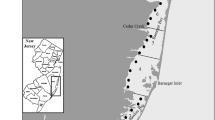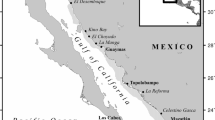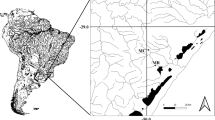Abstract
The gulf pipefish,Syngnathus scovelli, is the dominant syngnathid found in coastal regions of the Gulf of Mexico and is the only species in this region known to occur in both freshwater and saltwater habitats. Relatively little is known about the population and reproductive cycles ofS. scovelli, particularly for those found in low salinity environments. The focus of the current study was to collect population structure and reproductive data forS. scovelli from a low salinity habitat, Meaher Park, located at the mouth of Mobile Bay, Alabama. Sampling was conducted twice a month from January 2003 to January 2004. Environmental parameters, as well as population and reproductive parameters, were collected. Water temperature was the primary abiotic factor associated with both the appearance ofS. scovelli and their breeding cycle. Based on gonadosomatic (GSI) and brood pouch somatic indices (BPSI), females and males were reproductively active throughout the summer. Peaks in male GSI and BPSI were consistent with the subsequent appearance of a large number of juveniles in early fall. These event coincided with the higher temperatures seen during late summer and early fall. Sex ratios (male : female 1 : 1.64) and operational sex ratios (1 : 4.09) indicated that this was a female biased population. Although there was no difference in the average size of males and females in this population, the largest individuals collected were female. The female-biased sex ratio supports previous genetic analyses suggesting thatS. scovelli exhibits true sex-role reversal and that operational sex ratios are a reliable indicator of the intensity of mating competition and sex roles.
Similar content being viewed by others
Literature cited
Allen, Y., A. Scott, P. Matthiessen, S. Haworth, J. Thain, andS. Feist. 1999. Survey of estrogenic activity in the United Kingdom estuarine and coastal water and its affects on gonadal development of the flounderPlatichthys flesus.Environmental Toxicology and Chemistry 18:1791–1800.
Amos, W. H. andS. H. Amos. 1985. Atlantic and Gulf Coasts, The Audubon Society Nature Guides, revised edition. Alfred A. Knopf, New York.
Anderson, R. O. andS. J. Gutreuter. 1983. Length, weight, and associated structural indices, p. 283–300.In L. A. Nielson and D. L. Johnson (eds.), Fisheries Techniques. American Fisheries Society, Bethesda, Maryland.
Andersson, M. 1994. Sexual Selection. Princeton University Press, Princeton, New Jersey.
Bateman, A. J. 1948. Intra-sexual selection inDrosophila.Heredity 2:349–368.
Berglund, A. 1991. Egg competition in a sex-role reversed pipefish: Subdominant females trade reproduction for growth.Evolution 45:770–774.
Berglund, A., G. Rosenqvist, andI. Svensson. 1986. Reversed sex roles and parental energy investment in zygotes of two pipefish (Syngnathidae) species.Marine Ecology Progress Series 29: 209–215.
Brown, J. D. 1972. A comparative life history study of four species of pipefish (Family Syngnathidae). Ph.D. Dissertation, University of Florida, Gainesville, Florida.
Burn, D. A. and T. A. Ryan. 1983. A Diagnostic Test for Lack Of Fit in Regression Models, p. 286–290.In Proceedings of the Statistical Computing Section of the American Statistical Association, Detroit, Michigan.
Campbell, B. C. andW. K. Able. 1998. Life history characteristics of the northern pipefish,Syngnathus fuscus, in southern New Jersey.Estuaries 21:470–475.
Duffy, K. C. andD. M. Baltz. 1998. Comparison of fish assemblages with native and exotic submerged macrophytes in the Lake Pontchartrain estuary, USA.Journal of Experimental Marine Biology and Ecology 223:199–221.
Forsgren, E., T. Amundsen, A. A. Borg, andJ. Bjelvenmark. 2004. Unusually dynamic sex roles in a fish.Nature 429:551–554.
Franzoi, P., R. MacCagnani, R. Rossi, andV. U. Ceccherelli. 1993. Life cycles and feeding habits ofSyngnathus taenionotus andS. abaster (Pisces, Syngnathidae) in a brackish bay of the Po River Delta (Adriatic Sea).Marine Ecology Progress Series 97:71–81.
Gasparini, J. L. andR. L. Teixeria. 1999. Reproductive aspects of the gulf pipefishSyngnathus scovelli (Teleostei: Syngnathidae), from southeastern Brazil.Revista Brasileira de Biologia 59:87–90.
Goede, R. W. andB. A. Barton. 1990. Organismic indices and an autopsy-based assessment as indicators of fish health and condition of fish, p. 93–108.In Symposium 8, American Fisheries Society. American Fisheries Society, Bethesda, Maryland.
Gutjahr-Gobell, R. E., M. Huber, H. Borsay, G. E. Zaroogian, andL. J. Mills. 2002. A temperate reed fish,Tautogolabrus adspersus, (Walbaum) as a potential model species for laboratory studies evaluating reproductive effects of chemical exposure.Environmental Toxicology and Chemistry 21:380–389.
Hamilton, Jr.,W. J. 1942. Habits ofSyngnathus scovelli (Evermann and Kendall).Copeia 3:188.
Hemming, J. M., W. T. Waller, M. C. Chow, N. D. Denslow, andB. Venables. 2001. Assessment of the estrogenicity and toxicity of a domestic wastewater effluent flowing through a constructed wetland system using biomarkers in the male fathead minnow (Pimephales promelas Rafinescue, 1820).Environmental Toxicology and Chemistry 20:2268–2275.
Henderson, B. A., J. L. Wong, andS. J. Nepszy. 1996. Reproduction of walleye in Lake Erie: Allocation of energy.Canadian Journal of Fisheries and Aquatic Sciences 53:127–133.
Herald, E. S. andC. E. Dawson. 1972. A new subspecies of the gulf pipefishSyngnathus scovelli kamahi Pisces Syngnathidae.Copeia 4:781–784.
Hoese, H. D. andR. H. Moore. 1992. Fishes of the Gulf of Mexico: Texas, Louisiana and Adjacent Waters, 1st edition. Texas A&M University Press, College Station, Texas.
Jones, A. G. andJ. C. Avise. 1997. Microsatellite analysis of maternity and the mating system in the gulf pipefishSyngnathus scovelli, a species with male pregnancy and sex-role reversal.Molecular Ecology 6:203–213.
Jones, A. G., E. Walker, andJ. C. Avise. 2001. Genetic evidence for extreme polyandry and extraordinary sex-role reversal in a pipefish.Proceedings of the Royal Society of London B 268: 2531–2535.
Joseph, E. B. 1957. A study of the systematics and life history of the gulf pipefish,Syngnathus scovelli (Evermann and Kendall). Ph.D. Dissertation, Florida State University, Tallahassee, Florida.
Kokko, H. andR. A. Johnstone. 2002. Why is mutual mate choice not the norm? Operational sex ratios, sex roles and the evolution of sexually dimorphic and monomorphic signaling.Philosophical Transactions of the Royal Society of London B 357: 319–330.
Kokko, H. andP. Monaghan. 2001. Predicting the direction of sexual selection.Ecology Letters 4:159–165.
Kornienko, E. S. 2001. Reproduction and development in some genera of pipefish and seahorses of the family Syngnathidae.Russian Journal of Marine Biology 27:S15-S26.
Lazzari, M. A. andK. W. Able. 1990. Northern pipefish,Syngnathus fuscus, occurrences over the Mid-Atlantic Bight continental shelf: Evidence of seasonal migration.Environmental Biology of Fishes 27:177–185.
Mayer, I. 1993. Plasma levels of sex steroids in three species of pipefish.Canadian Journal of Zoology 71:1903–1907.
Maynard Smith, J. 1991. Theories of sexual selection.Trends in Ecology and Evolution 6:146–151.
McLane, W. M. 1955. The fishes of the St. Johns River system. Ph.D. Dissertation, University of Florida, Gainesville, Florida.
Neter, J., W. Wasserman, andM. H. Kuter. 1990. Applied Linear Statistical Models. Regression, Analysis of Variance and Experimental Design, 3rd edition. Irwin, Homewood, Illinois.
Ott, R. L. 1993. An Introduction to Statistical Methods and Data Analysis, 4th edition. Duxbury Press, Belmont, California.
Partridge, C. 2003. The reproductive physiology, biochemistry and histology of the gulf pipefish,Syngnathus scovelli. M.S. Thesis, University of South Alabama, Mobile, Alabama.
Partridge, C., C. Cazalas, J. Rozelle, J. Hemming, andA. Boettcher. 2004. Small-scale captive breeding of a euryhaline pipefish.World Aquaculture September:51–54.
Power, M. andM. J. Attrill. 2003. Long-term trends in the estuarine abundance of Nilsson’s pipefish (Syngnathus rostellatus Nilsson).Estuarine, Coastal, and Shelf Science 57:325–333.
Quast, W. D. andN. R. Howe. 1980. The osmotic role of the brood pouch in the pipefishSyngnathus scovelli.Comparative Biochemistry and Physiology 67:675–678.
Shipp, R. L. 1986. Dr. Bob Shipp’s Guide to the Fishes of the Gulf of Mexico. Century Printing Company, Mobile, Alabama.
Takahashi, E., R. M. Connolly, andS. Y. Lee. 2003. Growth and reproduction of double-ended pipefish,Syngnathoides biaculeatus, in Moreton Bay, Queensland, Australia.Environmental Biology of Fishes 67:23–33.
Targett, T. E. 1984. A breeding population of Gulf pipefish (Syngnathus scovelli) in a Georgia estuary.Contributions in Marine Science 27:169–174.
Teixeira, R. L. 1995. Reproductive and feeding biology of selected syngnathids (Pisces: Teleostei) of the western Atlantic. Ph.D. Dissertation, The College of William and Mary, Williamsburg, Virginia.
Trivers, R. 1972. Parental investment and sexual selection, p. 139–179.In B. Campbell (ed.), Sexual Selection and the Descent of Man. Aldine Press, Chicago, Illinois.
Ueda, N., C. Partridge, J. Bolland, J. Hemming, T. Sherman, andA. Boettcher. 2005. Effects of an environmental estrogen on male gulf pipefish,Syngnathus scovelli (Evermann and Kendall) a male brooding teleost.Bulletin of Environmental Contamination and Toxicology 74:1207–1212.
Vincent, A., I. Ahnesjo, A. Berglund, andG. Rosenqvist. 1992. Pipefish and seahorses: Are they all sex role reversed?Trends in Ecology and Evolution 7:237–241.
Vincent, A., A. Berglund, andI. Ahnesjo. 1995. Reproductive ecology of five pipefish species in one eelgrass meadow.Environmental Biology of Fishes 44:347–361.
Whatley, E. C. 1969. A study ofSyngnathus scovelli in fresh waters of Louisiana and salt waters of Mississippi.Gulf Research Reports 2:437–473.
Zar, J. H. 1984. Biostatistical Analysis, 2nd edition, Prentice-Hall, Inc., Englewood Cliffs, New Jersey.
Author information
Authors and Affiliations
Corresponding author
Rights and permissions
About this article
Cite this article
Bolland, J., Boettcher, A. Population structure and reproductive characteristics of the gulf pipefish,Syngnathus scovelli, in Mobile Bay, Alabama. Estuaries 28, 957–965 (2005). https://doi.org/10.1007/BF02696023
Received:
Revised:
Accepted:
Issue Date:
DOI: https://doi.org/10.1007/BF02696023




